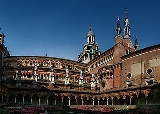
Certosa di Pavia
Encyclopedia
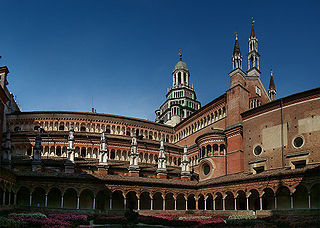
Monastery
Monastery denotes the building, or complex of buildings, that houses a room reserved for prayer as well as the domestic quarters and workplace of monastics, whether monks or nuns, and whether living in community or alone .Monasteries may vary greatly in size – a small dwelling accommodating only...
and complex in Lombardy
Lombardy
Lombardy is one of the 20 regions of Italy. The capital is Milan. One-sixth of Italy's population lives in Lombardy and about one fifth of Italy's GDP is produced in this region, making it the most populous and richest region in the country and one of the richest in the whole of Europe...
, northern Italy
Italy
Italy , officially the Italian Republic languages]] under the European Charter for Regional or Minority Languages. In each of these, Italy's official name is as follows:;;;;;;;;), is a unitary parliamentary republic in South-Central Europe. To the north it borders France, Switzerland, Austria and...
, situated near a small town of the same name in the Province of Pavia
Province of Pavia
The Province of Pavia is a province in the region of Lombardy in northern Italy. Pavia is the capital.It has an area of 2,965 km², and a total population of 493,753...
, 8 km north of Pavia
Pavia
Pavia , the ancient Ticinum, is a town and comune of south-western Lombardy, northern Italy, 35 km south of Milan on the lower Ticino river near its confluence with the Po. It is the capital of the province of Pavia. It has a population of c. 71,000...
. Built in 1396-1495, It was once located on the border of a large hunting park belonging to the Visconti
House of Visconti
Visconti is the family name of two important Italian noble dynasties of the Middle Ages. There are two distinct Visconti families: The first one in the Republic of Pisa in the mid twelfth century who achieved prominence first in Pisa, then in Sardinia where they became rulers of Gallura...
family of Milan
Milan
Milan is the second-largest city in Italy and the capital city of the region of Lombardy and of the province of Milan. The city proper has a population of about 1.3 million, while its urban area, roughly coinciding with its administrative province and the bordering Province of Monza and Brianza ,...
, of which today only scattered parts remain.
Certosa is the Italian name for a house of the cloistered monastic order of Carthusians founded by St. Bruno in 1044 at Grande Chartreuse
Grande Chartreuse
Grande Chartreuse is the head monastery of the Carthusian order. It is located in the Chartreuse Mountains, north of the city of Grenoble, in the commune of Saint-Pierre-de-Chartreuse , France. Originally, the château belonged to the See of Grenoble...
. Though the Carthusians in their early centuries were known for their seclusion and asceticism and the plainness of their architecture, the Certosa is renowned for the exuberance of its architecture, in both the Gothic and Renaissance styles, and for its collection of artworks which are particularly representative of the region.
History

Gian Galeazzo Visconti
Gian Galeazzo Visconti , son of Galeazzo II Visconti and Bianca of Savoy, was the first Duke of Milan and ruled the late-medieval city just before the dawn of the Renaissance...
, hereditary lord and first Duke of Milan, commissioned the building of the Certosa to the architect Marco Solari
Marco Solari
Marco Solari was an Italian architect and engineer.He was born in Carona, in what today is the Swiss canton of Ticino, and was the father of the architect Giovanni Solari....
, inaugurating the works and laying the foundation stone on August 27, 1396, as recorded by a bas-relief on the facade. The location was strategically chosen midway between Milan and Pavia, the second city of the Duchy, where the Duke held his court.
The church, the last edifice of the complex to be built, was to be the family mausoleum
Mausoleum
A mausoleum is an external free-standing building constructed as a monument enclosing the interment space or burial chamber of a deceased person or persons. A monument without the interment is a cenotaph. A mausoleum may be considered a type of tomb or the tomb may be considered to be within the...
of the Visconti. It was designed as a grand structure with a nave and two aisles, a type unusual for the Carthusian Order. The nave, in the Gothic style, was completed in 1465.
However, since the foundation, the Renaissance had spread in Italy, and the rest of the edifice was built according to the new style, redesigned by Giovanni Solari
Giovanni Solari
Giovanni Solari was an Italian architect and engineer.He was born in Milan, the son of the architect Marco Solari, who was chief of the works of the Duomo of Milan. Giovanni Solari directed the construction of the Certosa di Pavia from 1428 to 1462 and that of the Duomo from 1452 to 1469. He was...
continued by his son Guiniforte Solari
Guiniforte Solari
Guiniforte Solari , also known as Boniforte, was an Italian sculptor, architect and engineer.Born in Milan, he was the son of the architect Giovanni Solari, and brother of Francesco Solari....
and including some new cloisters. Solari was followed as director of the works by Giovanni Antonio Amadeo
Giovanni Antonio Amadeo
thumb|260px|The Colleoni Chapel in Bergamo.Giovanni Antonio Amadeo was an Italian early Renaissance sculptor, architect, and engineer....
, (1481-1499). The church was consecrated on May 3, 1497. The lower part of the façade was not completed until 1507.
The construction contract obliged the monks to use part of the revenue of the lands held in benefice
Benefice
A benefice is a reward received in exchange for services rendered and as a retainer for future services. The term is now almost obsolete.-Church of England:...
to the monastery to continue to improve the edifice. Consequently, the Certosa includes a huge collection of artworks of all centuries from the 15th to the 18th.
In 1782, the Carthusians were expelled by the Emperor Joseph II of Austria, and were succeeded at the Certosa by the Cistercians in 1784 and then by the Carmelites
Carmelites
The Order of the Brothers of Our Lady of Mount Carmel or Carmelites is a Catholic religious order perhaps founded in the 12th century on Mount Carmel, hence its name. However, historical records about its origin remain uncertain...
in 1789. In 1810 the monastery was closed until the Carthusians reacquired it in 1843. In 1866 it was declared a National Monument and sequestrated by the Italian State, although some Benedictines resided there until 1880. The monks currently living in the monastery are Cistercians admitted to it in the 1960s.
The church
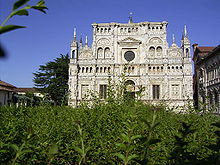
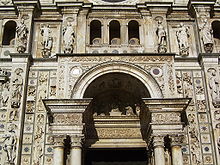

Nave
In Romanesque and Gothic Christian abbey, cathedral basilica and church architecture, the nave is the central approach to the high altar, the main body of the church. "Nave" was probably suggested by the keel shape of its vaulting...
, two aisles and transept
Transept
For the periodical go to The Transept.A transept is a transverse section, of any building, which lies across the main body of the building. In Christian churches, a transept is an area set crosswise to the nave in a cruciform building in Romanesque and Gothic Christian church architecture...
, typical of Gothic architecture
Gothic architecture
Gothic architecture is a style of architecture that flourished during the high and late medieval period. It evolved from Romanesque architecture and was succeeded by Renaissance architecture....
. The chancel
Chancel
In church architecture, the chancel is the space around the altar in the sanctuary at the liturgical east end of a traditional Christian church building...
terminates with an apse
Apse
In architecture, the apse is a semicircular recess covered with a hemispherical vault or semi-dome...
. It is covered by crossed vaults on Gothic arches and is inspired, on a reduced scale, by the Duomo of Milan. The vaults are alternatively decorated with geometrical shapes and starry skies. The transept and the main chapel end with square-plan chapels with smaller, semi-circular apses on three sides.
The façade of the church is famous for its exuberant decorations, typical of Lombard
Lombardy
Lombardy is one of the 20 regions of Italy. The capital is Milan. One-sixth of Italy's population lives in Lombardy and about one fifth of Italy's GDP is produced in this region, making it the most populous and richest region in the country and one of the richest in the whole of Europe...
architecture, every part being decorated with reliefs, inlaid marble and statues. Sculptors who worked on it include Cristoforo Mantegazza
Cristoforo Mantegazza
Cristoforo Mantegazza was an Italian sculptor who was active from 1464.He was born in Pavia. Among his other works, he collaborated with his brother Antonio on the façade of the Certosa of Pavia , one of the masterworks of northern Italy's Renaissance...
and Giovanni Antonio Amadeo himself. In addition to applied sculpture, the facade itself has a rich sculptural quality because of the contrast between richly textured surfaces, projecting buttresses, horizontal courses and arched openings, some of which are shadowed, while those in the small belfries are open to the sky.
The sober form of the roughly finished brick front can be seen in a fresco by Ambrogio Bergognone
Ambrogio Bergognone
Ambrogio Borgognone Ambrogio Borgognone Ambrogio Borgognone (variously known as Ambrogio da Fossano, Ambrogio di Stefano da Fossano, Ambrogio Stefani da Fossano or as il Bergognone, c...
in the apse of the right transept, painted in 1492-1495, when work was commencing on the new facade, portraying Gian Galeazzo Visconti offering the model of the Certosa to the Blessed Virgin. Its profile, with roofs on three levels, has been compared to the churches of San Giovanni in Monza and San Petronio in Bologna; among the architects in close correspondence at all three projects, Borlini ascribes the form of the original facade at the Certosa to Giacomo da Campione, who was working at Pavia while his uncle Matteo was completing San Giovanni in Monza.
The architect Giovanni Solari
Giovanni Solari
Giovanni Solari was an Italian architect and engineer.He was born in Milan, the son of the architect Marco Solari, who was chief of the works of the Duomo of Milan. Giovanni Solari directed the construction of the Certosa di Pavia from 1428 to 1462 and that of the Duomo from 1452 to 1469. He was...
, in building the double row of arcades down the flanks of the church, modified its appearance. After his death he was succeeded in Pavia by his son Guiniforte Solari
Guiniforte Solari
Guiniforte Solari , also known as Boniforte, was an Italian sculptor, architect and engineer.Born in Milan, he was the son of the architect Giovanni Solari, and brother of Francesco Solari....
, but work came to a halt with the death of Guiniforte in 1478.
In 1492 Gian Giacomo Dolcebono took up the construction, assisted on site, for he was cocurrently occupied with the cathedrals at Pavia and at Milan and other churches, by his inseparable collaborator on both cathedrals, Giovanni Antonio Amadeo. In their hands the project was thoroughly redesigned. Scores of artists were involved. The classicist style portal is by Benedetto Briosco
Benedetto Briosco
thumb|300px|The portal of the Certosa di Pavia.Benedetto Briosco was an Italian Renaissance sculptor and architect, active in Lombardy....
(1501). The porch has a large arch of classicist form resting on paired Corinthian columns
Corinthian order
The Corinthian order is one of the three principal classical orders of ancient Greek and Roman architecture. The other two are the Doric and Ionic. When classical architecture was revived during the Renaissance, two more orders were added to the canon, the Tuscan order and the Composite order...
which are each surmounted by a very strongly modelled cornice
Cornice
Cornice molding is generally any horizontal decorative molding that crowns any building or furniture element: the cornice over a door or window, for instance, or the cornice around the edge of a pedestal. A simple cornice may be formed just with a crown molding.The function of the projecting...
on which the arch rests, the construction being derived from the Classical, used by Brunelleschi
Filippo Brunelleschi
Filippo Brunelleschi was one of the foremost architects and engineers of the Italian Renaissance. He is perhaps most famous for inventing linear perspective and designing the dome of the Florence Cathedral, but his accomplishments also included bronze artwork, architecture , mathematics,...
, and employed here for a bold and striking effect. The decoration is of bas-reliefs illustrating the History of the Certosa. Above the central arch is a shallow balcony of three arches, above which rises the central window.
This campaign was interrupted in 1519 as work was going forward by the condition of French occupation in Lombardy after the War of the League of Cambrai
War of the League of Cambrai
The War of the League of Cambrai, sometimes known as the War of the Holy League and by several other names, was a major conflict in the Italian Wars...
. French troops were encamped round the Certosa. Notations of work on the facade did not resume until 1554, when a revised design under the direction of Cristoforo Lombardo was approved for the completion of the facade above the second arcade; there marble intarsia was substituted for the rich sculptual decorations of the lower area. Some final details were added by Galeazzo Alessi
Galeazzo Alessi
Galeazzo Alessi was an Italian architect from Perugia, known throughout Europe for his distinctive style based on his enthusiasm for ancient architecture. He studied drawing for civil and military architecture under the direction of Giovanni Battista Caporali.For a number of years he lived in Genoa...
.
The Small and Grand Cloisters
An elegant portal, with sculptures by the Mantegazza brothers and Giovanni Antonio Amadeo, leads from the church to the Small Cloister (in Italian: Chiostro Piccolo.) This has a small garden in the center. The most striking feature is the terracotta decoration of the small pilasters, executed by Rinaldo de Stauris between 1463 and 1478. Some arcades are decorated by frescoes by Daniele Crespi, now partially ruined. Also noteworthy is the late-14th century lavaboLavabo
A lavabo is a device used to provide water for the washing of hands. It consists normally of a ewer or container of some kind to pour water, and a bowl to catch the water as it falls off the hands. In ecclesiastical usage it refers to both the basin in which the priest washes his hands and the...
in stone and terracotta, with scenes of the Jesus with the Woman of Samaria at the Well.
Similar decorations also characterize the Grand Cloister (Italian: Chiostro Grande), which measures c.125x100 meters. The elegant cells of the monks open to the central garden. The arcades have columns with precious decorations in terracotta, with tondoes portraying saints, prophets and angels, alternatively in white and pink Verona
Verona
Verona ; German Bern, Dietrichsbern or Welschbern) is a city in the Veneto, northern Italy, with approx. 265,000 inhabitants and one of the seven chef-lieus of the region. It is the second largest city municipality in the region and the third of North-Eastern Italy. The metropolitan area of Verona...
marble. There were once also paintings by Vincenzo Foppa, now disappeared.
Paintings
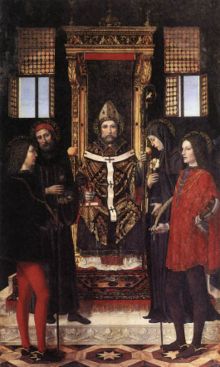
Francesco I Sforza
Francesco I Sforza was an Italian condottiero, the founder of the Sforza dynasty in Milan, Italy. He was the brother of Alessandro, with whom he often fought.-Early life:...
and Ludovico Sforza
Ludovico Sforza
Ludovico Sforza , was Duke of Milan from 1489 until his death. A member of the Sforza family, he was the fourth son of Francesco Sforza. He was famed as a patron of Leonardo da Vinci and other artists, and presided over the final and most productive stage of the Milanese Renaissance...
. Other frescoes with saints and prophets were executed by Lombard artists, including a young Bernardino Zenale.
The Certosa has painted masterpieces by Bergognone including the panels of St. Ambrose (1490), and San Siro (1491) and, most significantly, the Crucifixion (1490). Other works by Bergognone are now found in other museums of Europe.
Other paintings in the church include a Holy Father, panels by Giovanni Battista Crespi
Giovanni Battista Crespi
Giovanni Battista Crespi , called Il Cerano, was an Italian painter, sculptor, and architect,-Biography:...
, Il Morazzone, Guercino, Francesco Cairo
Francesco Cairo
Francesco Cairo was an Italian painter active in Baroque Lombardy and Piedmont.He was born and died in Milan. It is not known where he obtained his early training though he is strongly influenced by the circle of il Morazzone, in works such as the Saint Teresa altarpiece in the Certosa di Pavia.In...
and Daniele Crespi
Daniele Crespi
Daniele Crespi was an Italian painter of the Baroque era. He was born in Busto Arsizio, and active mostly in the Milan of Federico Borromeo....
, and a remnant of a polyptych by Perugino Originally depicting the Madonna and Saints, it is now disassembled and scattered among museums: the only portion in the Certosa is God the Father with cherubim. An Annunciation has disappeared; three panels, the Virgin Adoring the Infant Christ, St. Michael and St. Raphael with Tobias are on display at the National Gallery of London, in the United Kingdom.
In the southern transept is the tomb of Gian Galeazzo Visconti, begun in 1494-1497 by Giovanni Cristoforo Romano
Giovanni Cristoforo Romano
Giovanni Cristoforo Romano was an Italian Renaissance sculptor and medallist.Born in Rome to Isaia da Pisa, he was probably a pupil of Andrea Bregno. He first known works are in the Ducal Palace of Urbino, dating from before 1482...
and Benedetto Briosco
Benedetto Briosco
thumb|300px|The portal of the Certosa di Pavia.Benedetto Briosco was an Italian Renaissance sculptor and architect, active in Lombardy....
, but completed only in 1562. The northern transept houses the tomb of Ludovico Sforza
Ludovico Sforza
Ludovico Sforza , was Duke of Milan from 1489 until his death. A member of the Sforza family, he was the fourth son of Francesco Sforza. He was famed as a patron of Leonardo da Vinci and other artists, and presided over the final and most productive stage of the Milanese Renaissance...
("The Moor"), 7th Duke of Milan, and his wife Beatrice d'Este
Beatrice d'Este
Beatrice d'Este , duchess of Milan, one of the most beautiful and accomplished princesses of the Italian Renaissance, was the daughter of Ercole I d'Este and younger sister of Isabella d'Este and Alfonso d'Este....
. The sculptures on the tomb were carried here in 1564 from the Milanese church of Santa Maria delle Grazie, the statues generally being considered the masterwork of Cristoforo Solari
Cristoforo Solari
Cristoforo Solari , also known as il Gobbo , was an Italian sculptor and architect. He was the brother of the painter Andrea Solari....
.
Stained glass and other works
The Certosa possesses an important collection of stained glass windowsStained glass
The term stained glass can refer to coloured glass as a material or to works produced from it. Throughout its thousand-year history, the term has been applied almost exclusively to the windows of churches and other significant buildings...
, executed to cartoons by masters active in Lombardy in the 15th century, including Zanetto Bugatto, Vincenzo Foppa
Vincenzo Foppa
Vincenzo Foppa was a Northern-Italian Renaissance painter.He was an elderly contemporary of Leonardo da Vinci. Born at Bagnolo Mella, near Brescia in the Republic of Venice, he settled in Pavia around 1456, serving the dukes of Milan and emerging as one of the most prominent Lombard painters....
, Bergognone and Hans Witz.
There are many notable decorative sculptural works which include the carved wooden choir stalls, the marble altar frontals and the bronze candelabra by Annibale Fontana
Annibale Fontana
Annibale Fontana was an Italian sculptor, medallist and crystal-worker.Fontana was born in Milan. His first known work is a crystal case, now in the Schatzkammer of Munich, for Albert V of Bavaria . In 1570–1572 he was in Palermo, working for viceroy Francesco Fernardo d'Avalos, of whom he made a...
. Also notable is the high altar from the late 16th century. The crypt sacristy contains, among other treasures, a triptych in ivory
Ivory
Ivory is a term for dentine, which constitutes the bulk of the teeth and tusks of animals, when used as a material for art or manufacturing. Ivory has been important since ancient times for making a range of items, from ivory carvings to false teeth, fans, dominoes, joint tubes, piano keys and...
and hippopotamus
Hippopotamus
The hippopotamus , or hippo, from the ancient Greek for "river horse" , is a large, mostly herbivorous mammal in sub-Saharan Africa, and one of only two extant species in the family Hippopotamidae After the elephant and rhinoceros, the hippopotamus is the third largest land mammal and the heaviest...
' ivory by Baldassarre degli Embriachi, donated by Gian Galeazzo Visconti.
Other
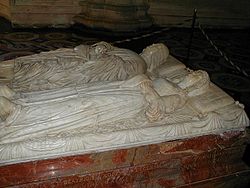
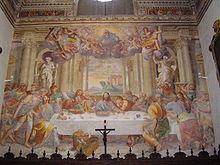
Siena
Siena is a city in Tuscany, Italy. It is the capital of the province of Siena.The historic centre of Siena has been declared by UNESCO a World Heritage Site. It is one of the nation's most visited tourist attractions, with over 163,000 international arrivals in 2008...
Mannerism
Mannerism
Mannerism is a period of European art that emerged from the later years of the Italian High Renaissance around 1520. It lasted until about 1580 in Italy, when a more Baroque style began to replace it, but Northern Mannerism continued into the early 17th century throughout much of Europe...
. The walls have paintings by Francesco Cairo, Camillo Procaccini
Camillo Procaccini
thumb|300px|Nativity by Camillo ProcacciniCamillo Procaccini was an Italian painter. He has been posthumously referred to as the Vasari of Lombardy, for his prolific Mannerist fresco decoration....
, il Passignano and Giulio Cesare Procaccini
Giulio Cesare Procaccini
Giulio Cesare Procaccini was an Italian painter and sculptor of the early Baroque era in Milan.-Biography:Born in Bologna he was son of the Mannerist painter Ercole Procaccini the Elder and brother of Camillo Procaccini and Carlo Antonio Procaccini...
, while the altarpiece of 1524 was begun by Andrea Solario, later completed by Bernardino Campi
Bernardino Campi
Bernardino Campi was an Italian Renaissance painter from Reggio Emilia, who worked in Cremona. He is known as one of the teachers of Sofonisba Anguissola and of Giovanni Battista Trotti . In Cremona, his extended family were the main artistic studios...
.
Also notable is the refectory, initially used as church during the construction, which has maintained a fresco with the Last Supper by Ottavio Semino, 1567 and, in the vault, a Madonna with Child and Prophets by Bergognone. In the Foresteria or Palazzo Ducale, built in the 17th century by Francesco Richino, are frescoes and paintings by Vincenzo and Bernardino Campi
Bernardino Campi
Bernardino Campi was an Italian Renaissance painter from Reggio Emilia, who worked in Cremona. He is known as one of the teachers of Sofonisba Anguissola and of Giovanni Battista Trotti . In Cremona, his extended family were the main artistic studios...
, Bartolomeo Montagna
Bartolomeo Montagna
Bartolomeo Montagna was an Italian painter and architect who worked in Vicenza and Venice. He putatively was born near Brescia . His initial training was presumably under Domenico Morone in Verona, where he seems to have acquired a late Quattrocento refinement, similar to that of Carpaccio and...
, Bergognone and Bernardino Luini
Bernardino Luini
Bernardino Luini was a North Italian painter from Leonardo's circle. Both Luini and Giovanni Antonio Boltraffio were said to have worked with Leonardo directly; he was described to have taken "as much from Leonardo as his native roots enabled him to comprehend". Consequently many of his works were...
.
In fiction
La Chartreuse de ParmeThe Charterhouse of Parma
The Charterhouse of Parma is a novel published in 1839 by Stendhal.-Plot summary:The Charterhouse of Parma tells the story of the young Italian nobleman Fabrice del Dongo and his adventures from his birth in 1798 to his death...
by Stendhal
Stendhal
Marie-Henri Beyle , better known by his pen name Stendhal, was a 19th-century French writer. Known for his acute analysis of his characters' psychology, he is considered one of the earliest and foremost practitioners of realism in his two novels Le Rouge et le Noir and La Chartreuse de Parme...
(Marie-Henri Beyle) is a novel, published in 1839, that rendered its author at last famous throughout Europe.
Parma is about 109 km from Pavia. The charterhouse the book refers to is probably the Valserena abbey of Paradigna, located in the surroundings of Parma.

